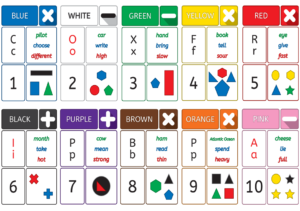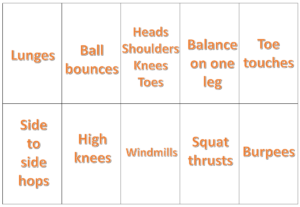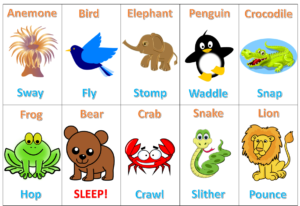Education, MY Classroom
We Like to Move it, Move it! (Includes FREE Movement Games & Activities PDF)
Movement Games and Activities List
Thanks to everyone who shared our EPIC resources post. It was our most popular one ever! We hope it makes life a little easier for those embarking upon homeschooling for the first time. As there are so many links included, finding appropriate content may feel a tad overwhelming. Because I went through the websites in detail before recommending, if you would like some advice or guidance on where to turn for resources for a particular topic or subject, please do not hesitate to reach out.
I would like to reiterate once again the benefits of structuring your homeschooling day with a timetable. (Discussed here.) If you are yet to make one, I urge you to do so. Children benefit greatly from structure and routine, and settling them into such a routine from the outset of school closures will likely make life much easier for all.
With that said, as promised, I would like to share a list of non screen-based activities your child may enjoy and learn from. As the list was so extensive, I have decided to share it in separate posts, beginning with outdoor and indoor play ideas that focus in the main on gross motor skills, although there are some fine motor ones to be found in here too.
Some of the activities will not be feasible for parents trying to juggle working from home, childcare and home-schooling; however, I hope you will find a few helpful ideas on the list. It is important to remember we are in unprecedented times and will each need to find what works for our own families. I have seen social media posts of parents being highly stressed about schoolwork that has been sent home, and I know this is absolutely not the intention of teachers, many of whom are also floundering in uncertainty at the minute. We can all but do our best right now and work together to support one another.
We often take on too much responsibility for keeping children busy and entertained. Learning to amuse themselves and indeed cope with boredom is important. I am mindful complaints of “I’m bored” can quickly grow tiring though. To address this, I recommend asking your child for a list of suggestions of things they can do when they have their free-time from home-school work. Write down all of the ideas and pull one out if they are complaining of boredom! You can then supplement their ideas with some of the suggestions from here.
As well as drawing up a list of ideas, I have also created a few downloadable activities for you. I describe these in the post and include the necessary resources in the attached PDF. You will need to print 4 pages in total if you would like to have all the activity cards.
Lots of movement is important for children. Children must develop their gross motor skills (big movements) before they master fine motor skills (precise movements), so it’s important to incorporate lots of games, sports and playing into daily life. You may find this gross motor skills checklist useful as it outlines expected milestones for children up to 8. You will find ideas in it for gross motor activities to add to those in the list below.
PE and Movement / Outdoor Games and Activities
Encourage children to play outside (being mindful of social distancing in communal areas).
-
Running and Chasing/Tag
-
Hopscotch
-
Skipping
-
Trampolining
-
Scooters
-
Cycling
-
Ball games (Basketball, tennis, football etc.)
-
Throwing and catching a ball. Add a learning element to this by calling out a sound or number as you throw the ball, When your child catches it, they must tell you a word beginning with that sound or 2 numbers that add to give you the number you called out. Change the challenges each time you play. You could call out a letter and your child tells you a place beginning with that letter etc.
-
Think of some sports day activities and try them: wheelbarrow race, sack race, egg and spoon race, old clothes race (Place old clothes, e.g. t-shirts, shorts, hat at intervals along the race route. Children must race to each point and dress in the items before continuing! Who will be the winner?!)
-
Go for a walk and see how many birds you can see along the way.
-
Search for insects in the garden. How many did you see? How many could you name?
-
Make and blow bubbles
-
Sand – play with wet and dry sand. Use a sieve to search for hidden objects.
-
Water play
-
Freeze small toys in ice (e.g., place in a muffin tray and fill with water). Can your child guess what is hidden? Watch them melt and see if they were correct! Some may enjoy trying to find ways to melt the ice quicker or chipping the ice away with a spoon.
-
Wash the car
-
Wash the outside windows
-
Have a water fight
Gardening / Garden Play
-
Plant seeds
-
Grow herbs
-
Pull weeds
-
Water the plants
-
Gather leaves to do leaf-rubbings
-
Snap twigs
-
Make a bird-feeder
-
Make a fairy garden
-
Make a mud pie
Indoor/Outdoor Activities
If the weather necessitates it, the following can be done inside.
-
Treasure hunt*
-
Hide-and-seek*
-
Exercise routines*
-
Circuit courses
-
Have a dance party or dance off
-
Build a fort or den
-
Toss beanbags/small balls into a laundry basket
-
Mirror exercises – one person leads and the others must copy what he or she does. Can you think of any funny movements to include?
-
Place masking tape on the floor/ground – in a line, a zigzag line or a curved line. Can your child…
-
Walk along it as if on a balance beam?
-
Roll a ball along the taped line with 2 hands and then with right hand and left hand only.
-
Drive and reverse toy cars along it.
-
*These activities are included in the attached PDF.
Animal Walks*
The attached *PDF includes animal walk challenge cards to use for this activity. Shuffle the cards and have your child select one and move like the animal on the card.
Can your child move like a/an…
-
Anemone (Sway from side to side)
-
Bear (Walk on all fours, moving left arm and leg forward together, setting them down, before moving right arm and leg forward together)
-
Bird (Arms outstretched for wings)
-
Crab (Sit down. Place hands either side of the body, palms down on the floor, facing outwards. Lift up bottom and torso. Move from side to side like a crab without dipping and touching the ground)
-
Crocodile (Snap – using a large clapping movement from the shoulders)
-
Elephant (Stomping around)
-
Frog (Squat. Place 2 arms between legs and then hop)
-
Lion (Pounce on prey)
-
Penguin (Waddle)
-
Snake (Slither on floor)
What animal walks and movements can your child add? Learn more about animal movements here.

What’s in the Download?
As well as resources for the animal movement activity above, use the cards in the download to play:

CardEd Hide and Seek
-
Hide the cards in various locations around the house. Can your child find them all?
-
If 2+ children are playing, print and hide 2 sets of the attached cards (numbers 1-10) and try some of these suggestions:
-
Who will be the first to find 2 cards of the same colour?
-
Who will be the first to find 2 cards with the same symbol?
-
Who will be the first to find 2 cards with a green shape?
-
Who will be the first to find a sequence of 3 numbers (e.g., 4,5,6 or 8,9,10).
-
**You may wish to add a rule that no-one is allowed to have more than 3 cards in their hand at any one time.
Treasure Hunts
Search for items based on the CardEd cards –
By Colour
-
Turn over a card. Identify the colour on the card. Search the room/house/outdoors for as many things as possible in that colour.
-
If playing with more than one child, give them a card each and see who can find the most objects in their given colour.
By Number
-
Turn over a card. Identify the number on the card. Create a set of that amount of objects, e.g., if 4 is revealed, your child may create a set of 4 toy cars or 4 leaves etc.
-
Can they create more than one set?
-
Can they add the sets together?
-
-
If playing with more than one child, give them a card each and have them make their sets of objects. Compare and contrast them afterwards.
-
Whose set is bigger/smaller?
-
Who had to find the most objects?
-
Do they think the game is fair?
-
What would be the worst card you could get (most challenging)?
-
What would be the best card you could get (easiest)?
-
By Colour and Number
-
Stack the cards in a pile. Turn one over. Look at the number and the colour. Ask your child to find that amount of items in the specific colour, e.g., 5 red items.
-
If more than one child is playing, allow them to pick 2 cards each and have a competition to see who will be the first to return with all the correct items. Up the movement level by creating a rule that they must bring each item back to base before looking for another one.
By Letter
-
Turn over a card. Identify the letter on the card. How many items can you find beginning with the letter on the card? If more than one child is playing, see who can collect the greatest number of items and compare.
-
Examine the cards before shuffling them and having your child choose one. Discuss which card they think would be the worst one to get and which they feel would be the best.
-
** Note: This also makes a good list game. Name as many things as you can beginning with this letter or write down as many things as you can starting with the letter on the card.
CardEd Fitness Challenge
This is a great activity for parents and children to take part in together.

-
Print the attached set of CardEd cards and the fitness challenges and cut them out.
-
Shuffle and place upside-down in 2 piles.
-
Decide on a length of time for the workout, e.g. 10 minutes and set a timer.
-
Ask your child to turn over a CardEd card and identify the number on there, e.g., 7
-
Select a fitness challenge, e.g., jumping jacks.
-
You must do 7 jumping jacks.
-
Choose the next 2 cards and continue.
-
Once all the CardEd number cards have been selected. Shuffle them and start again if the timer is still going. Do the same with the exercise cards.
-
Add some science to this activity by measuring each person’s heart-rate at the beginning and end of the workout.

Download and print an entire set of CardEd cards Set 1, Set 2, Set 3 and Set 4 and see our Activity Workbook for an even broader range of games and challenges.
Hopefully these activity ideas and games will be of help to you in working with your children in the coming days and weeks. Short movement breaks between lessons are really important for them, so use the cards provided as a way to get up and active for brief periods. Look out for part 2 of this post coming soon with lots more suggestions for you to try.
Aim for good over perfection. Do your best, and if things are overwhelming use the alternative bear card below (hibernating bear) to buy some quiet time!

If you have any questions or suggestions, please do not hesitate to get in touch. Sign up for our blog so that you never miss a post.
Get the Movement Games and Activities PDF

Pingback: EPIC Indoor Activities and Games List! Beat Boredom and Boost Learning!
Pingback: An Analogy to Explain why we #StayHome. Beauty in a Bear by Nancy L. Ogilvie.
Pingback: Positive Planning for Homeschooling: A Beginner’s Guide from Dumond with 5 Independent & 5 Collaborative Learning Activities.
Pingback: Mega Maths with CardEd!
Pingback: Promoting Speech, Language and Communication at Home
Pingback: 5 + 5 Activity Resource (No. 2) – 5 Independent & 5 Cooperative Learning Activities to Try!
Pingback: World Autism Awareness Day – Information, Resources and Tips
Pingback: Dumond Education’s EPIC List of Homeschooling Resources! – Dumond Education